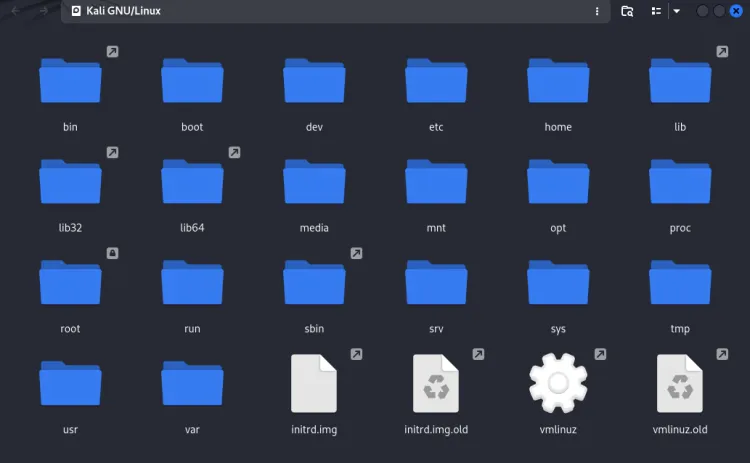What Is the File System Hierarchy in Kali Linux?
The file system hierarchy in Kali Linux organizes files and directories under the root directory (/). Key directories like /bin, /etc, /home, and /var serve specific purposes, from storing system binaries to user data and logs. Understanding this structure helps users navigate, secure, and maintain their systems effectively.

The file system hierarchy in Kali Linux, as in most Linux distributions, organizes files and directories in a structured and standardized way. This hierarchy follows the Filesystem Hierarchy Standard (FHS), which defines the locations and purposes of files and directories in Linux operating systems. Understanding this structure is essential for managing, navigating, and maintaining a Linux system efficiently.

The Root Directory (/)
At the top of the file system hierarchy is the root directory (/), which serves as the parent for all other directories and files. Each directory within / has a specific role and purpose, enabling easy organization and access to the system's resources.

Key Directories in the File System Hierarchy
Here’s a detailed overview of the primary directories found under / in Kali Linux and their purposes:
1. /bin (Binaries)
- Purpose: Contains essential system binaries (commands and programs) required for basic system operation.
- Examples of Files:
ls,cat,cp,mv,bash.
2. /sbin (System Binaries)
- Purpose: Stores system administration binaries used by the superuser (root) for system management tasks.
- Examples of Files:
fsck,reboot,iptables.
3. /boot
- Purpose: Contains files needed to boot the system, including the kernel, bootloader configuration files, and initial RAM disk.
- Examples of Files:
vmlinuz,initrd.img,grub.
4. /dev (Devices)
- Purpose: Houses device files that represent hardware components like disks, terminals, and printers.
- Examples of Files:
sda(hard drives),tty(terminals),null.
5. /etc (Configuration Files)
- Purpose: Contains configuration files and scripts for system and application settings.
- Examples of Files:
/etc/passwd: User account information./etc/fstab: File system mount points./etc/ssh/sshd_config: SSH server configuration.
6. /home
- Purpose: Stores personal directories for individual users. Each user gets a subdirectory for personal files and configurations.
- Examples:
/home/user1: Home directory foruser1./home/user2: Home directory foruser2.
7. /lib (Libraries)
- Purpose: Contains shared library files required by system binaries in
/binand/sbin. - Examples of Files:
ld-linux.so,libc.so.
8. /media
- Purpose: Temporary mount point for removable media, such as USB drives and CDs.
- Examples of Files:
/media/usb_drive.
9. /mnt (Mount)
- Purpose: Used for manually mounting file systems during system maintenance or troubleshooting.
- Examples:
/mnt/backup.
10. /opt (Optional Packages)
- Purpose: Reserved for installing optional third-party software and packages.
- Examples:
/opt/google/chrome.
11. /proc (Process Information)
- Purpose: A virtual file system that provides information about system processes and kernel parameters.
- Examples of Files:
/proc/cpuinfo: CPU details./proc/meminfo: Memory usage.
12. /root
- Purpose: Home directory for the root user.
- Note: This is different from
/, the root of the file system.
13. /run
- Purpose: Holds runtime data and system state files that are cleared at reboot.
- Examples of Files: PID files for running processes.
14. /srv (Service Data)
- Purpose: Stores data for services like web servers and FTP servers.
- Examples of Files:
/srv/www: Web server files.
15. /tmp (Temporary Files)
- Purpose: Temporary file storage, typically cleared on reboot.
- Examples of Files: Application cache or temporary downloads.
16. /usr (User System Resources)
- Purpose: Contains user programs, libraries, and documentation.
- Subdirectories:
/usr/bin: Non-essential binaries./usr/sbin: Non-essential system binaries./usr/lib: Libraries for/usr/binand/usr/sbin.
17. /var (Variable Files)
- Purpose: Stores variable data like logs, mail, and temporary files.
- Examples of Files:
/var/log: System logs./var/spool: Spool files for mail and printing.
Comparison Table of Key Directories
| Directory | Purpose | Examples |
|---|---|---|
/bin |
Essential binaries | ls, cp, bash |
/etc |
Configuration files | passwd, fstab |
/home |
User directories | /home/user1 |
/var |
Logs, temporary files | /var/log |
/lib |
Shared libraries | libc.so |
/boot |
Bootloader files | vmlinuz, grub |
/dev |
Device files | sda, tty |
Why Is Understanding the File System Hierarchy Important?
- Efficient Navigation: Knowing where files and directories reside speeds up troubleshooting and management tasks.
- Security: Properly managing directories like
/etcand/varhelps safeguard system configurations and logs. - System Maintenance: Understanding the hierarchy allows for effective backups, updates, and disk usage monitoring.
- Customization: Allows users to customize the system safely without disrupting critical files.
Best Practices for Managing the File System in Kali Linux
- Use Permissions Wisely: Ensure critical directories like
/etcand/varare properly secured. - Monitor Disk Usage: Regularly check storage with tools like
dfanddu. - Backup Regularly: Prioritize backing up directories like
/homeand/etc. - Avoid Root Misuse: Perform tasks as a normal user whenever possible to minimize risks.
Conclusion
The file system hierarchy in Kali Linux is designed for efficiency, security, and organization. By understanding the purpose of each directory, users can manage their systems effectively, perform troubleshooting tasks, and optimize system performance. Whether you’re a beginner or a seasoned Linux user, mastering the file system structure is a foundational skill.
FAQs
-
What is the root directory in Kali Linux?
- The root directory (
/) is the topmost directory in the file system hierarchy and contains all other directories and files on the system.
- The root directory (
-
What is stored in the
/bindirectory?- The
/bindirectory contains essential binary executables that are required for basic system operations, such asls,cp, andmv.
- The
-
What is the difference between
/binand/sbin?/bincontains essential binaries for all users, while/sbinholds system administration binaries that are primarily used by the root user for system maintenance tasks.
-
What is the
/etcdirectory used for?- The
/etcdirectory stores system-wide configuration files for system settings and application configurations.
- The
-
What is the purpose of the
/homedirectory?- The
/homedirectory holds the personal directories of users. Each user has a subdirectory under/homewhere their files and configurations are stored.
- The
-
What type of files are stored in
/var?- The
/vardirectory contains variable data such as system logs, spools (e.g., mail), and application runtime data that may change during operation.
- The
-
Can I install software in
/opt?- Yes,
/optis used to install third-party software and optional packages that are not part of the base Kali Linux installation.
- Yes,
-
What is the
/devdirectory?- The
/devdirectory contains device files that represent hardware components such as hard drives, printers, and terminals.
- The
-
What kind of files are stored in
/proc?- The
/procdirectory is a virtual file system that provides information about running processes and kernel parameters, such as CPU and memory usage.
- The
-
Why is it important to understand the file system hierarchy in Kali Linux?
- Understanding the file system hierarchy is crucial for effective system management, security, and troubleshooting, as it helps users navigate, modify, and protect system files in the correct locations.












![Top 10 Ethical Hackers in the World [2025]](https://www.webasha.com/blog/uploads/images/202408/image_100x75_66c2f983c207b.webp)

![[2025] Top 100+ VAPT Interview Questions and Answers](https://www.webasha.com/blog/uploads/images/image_100x75_6512b1e4b64f7.jpg)









